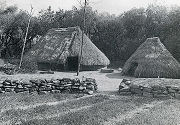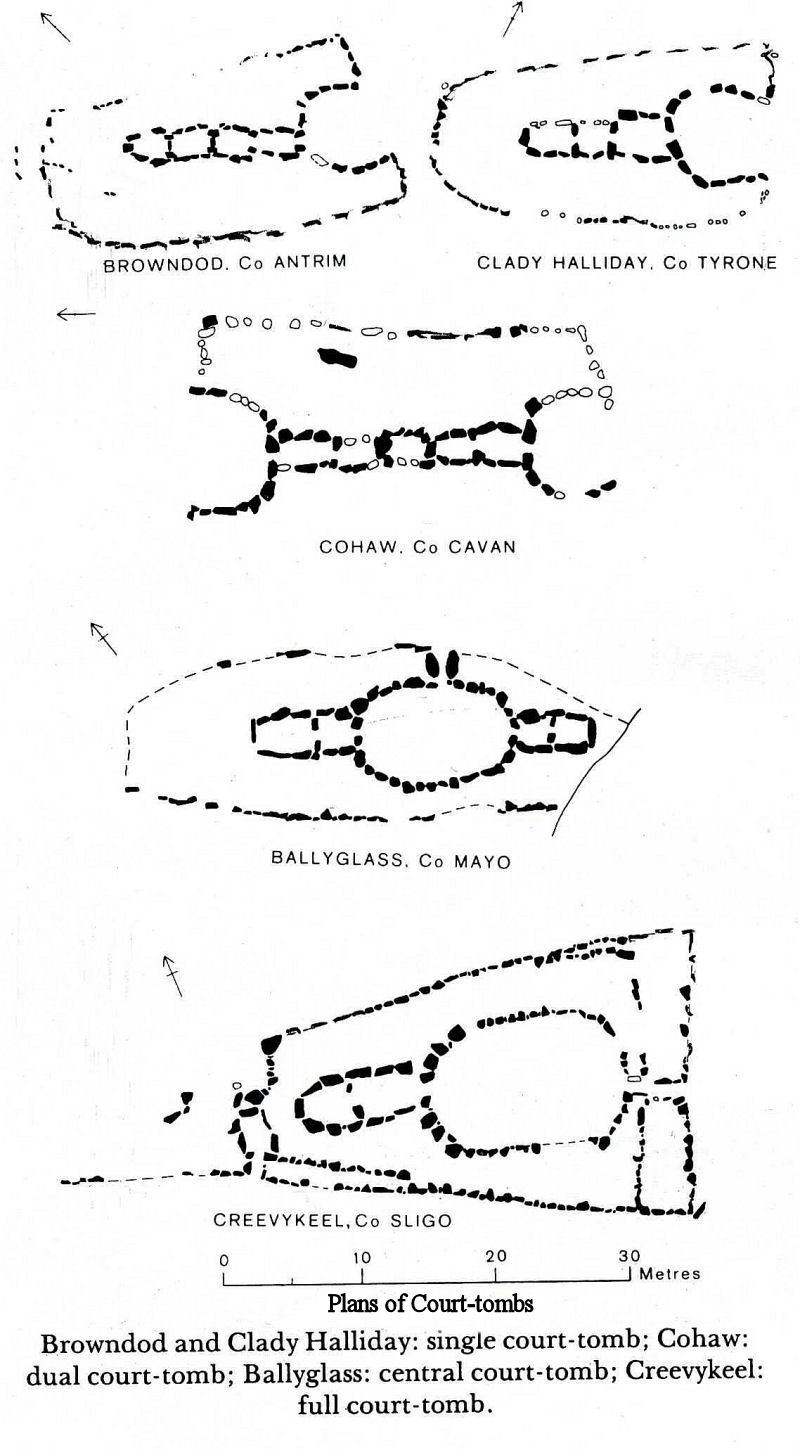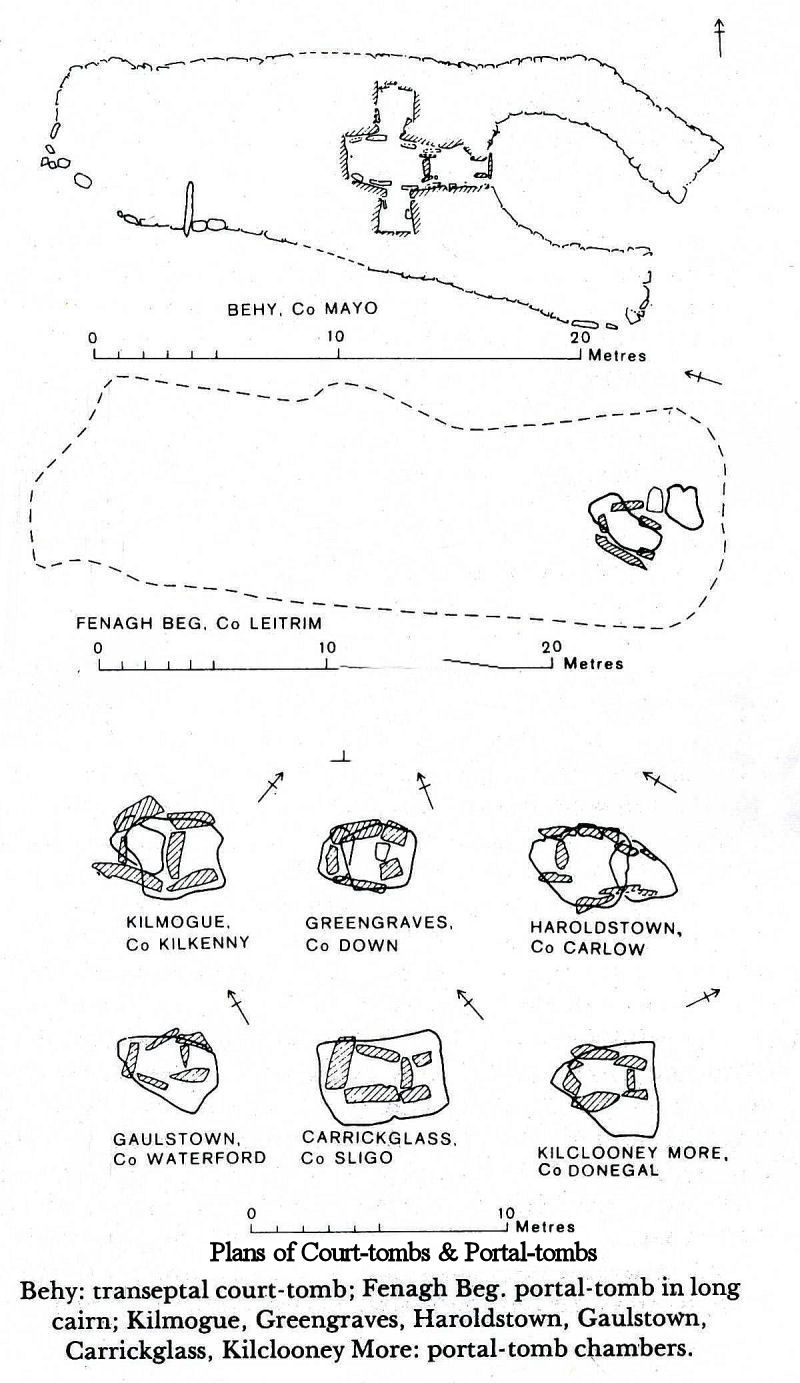A Hundred Million Years Ago
Doinaosaurs
............
650,000 BC - Old Stone Age (Palaeothic Age) - 7000 BC
Man - hunters - simple stone and stick tools
............. |
7000 BC - Middle Stone Age (Mesolithic Age) - 4000 BC
Man arrives in Ireland
Hunters - stone, wood and bone tools of knives, arrows, spears, harpoons, axes, choppers, chisels, awls, scrapers, and picks.
Pine, birch and willow covered the countryside
Pigs, hare, red deer, brown bears and birds such as duck, pigeon and grouse were plentiful
Rivers and lakes teemed with fish |

camp-site of saplings with animal skins as cover
............ |
4000 BC - New Stone Age (Neolithic Age) - 2000 BC
Farming began about 4000 BC, grazing stock and growing crops. Oak and elm were plentiful. Fences were erected to protect animals and crops. Houses were made of timber or wattle daubed with clay and with thatched roofs. |
|

Farmstead & outhouse & front of field with wheat in ridges
|
 |
| Glossary: |
|
megalithic: megas(Gk), great, lithos, stone
dolmen: simple type of megalithic tomb
cromlech: stone circle
cairn: a mound of stone erected as a monument or marker
barrow: heap of earth placed over a prehistoric tomb: long barrows are
Neolithic; round-barrows are Bronze Age
wedge: V-shaped block of rock
dry-stone: made without mortar
orthostats: upright stones
portol: entrance
corbel: a truss of stone
corbelling: laying a stone to form a corbel
jambs: the vertical inside face stone of an opening
jambstones: two vertical inside face stones of an opening
kerbs: a line of stone forming an edge
facade: the face of a building, esp. the main front
capstone: a slab of stone on top of structure
septal: forming a dividing partition
|
|
|
Megalithic Tombs are great tombs of stone - Court tombs, Portal tombs and Passage Tombs - intended for 'collective burial'. The cult arose in the Mediterranean area and came to Ireland from western France, particularly from Brittany, in the third and fourth millennia BC. (Refer to Timeline.) There are at least thirteen hundred megalithic tombs extant in Ireland; countless others have been destroyed in the course of time. It should be remembered, however, that when we look at a megalithic tomb that we are often looking at the skeleton of the structure only, the covering mount and the subsidiary features such as the cairns having been removed. Thus we may see the chamber, consisting of supporting stones and roof only.
|
|
Irish Megalithic Tombs
|
|
Three Classes: Long-barrow Tombs, Passage Tombs & Wedge Tombs
|
|
Long-barrow Tombs
|
|
Two types
|
|
Court Tombs & Portal Tombs
|
|

|
|
1 Here the burial chambers are set in long straight-sided cairns which taper from a broad front to a narrow end behind the burial chambers.
2 The side and back of the cairns are demarcated by a kerb or retaining wall of dry-stone sometime with set upright stones.
3 The cairns vary considerably in length from 20m to 60m
4 These tombs incorporated in their structure a ritual unroofed court with some fully enclosed save for a narrow entrance.
5 The burial gallery opens from the inner end of the court and its entry is marked by two well-matched jambstones. The gallery consists of two, three or four chambers divided from each other by
jambs. Sometimes a sillstone crosses the space between the jambs, and sometimes instead of the sill, higher slabs called septal-stone are used completely closing the gap between the jambs.
6 The cairns completely enveloped the chamber and filled the area between the kerbs, frontal façade and court.
|
 |
1 Portal tombs are almost always single chambered. Two tall, well-matched upright stones form impressive entry jambs with a slab set between the portal jambs closing the entry. The front of the
capstone, which is usually the more massive end, is poised on the jambs completing the characteristically impressive entrance from which the type is named. The capstone slopes downwards from
the portals and is supported also on the backstone rather than on the sidestones.
2 The cairns of portal tombs are often poorly preserved.
3 Occasionally, the capstone is found poised on the portals and backstone and the cairns have been stripped away. The term ‘dolmen’ is sometimes applied to these. |
 |
1 Among passage tombs are the more spectacular monuments, witness to the prestige of the leaders of the communities and their high degree of social organization.
2 A passage tomb consists of a burial chamber which is entered by a passage often of considerable length, the whole covered by a round mound usually surrounded by a kerb.
3 The plan above with a single pair of side-cells and an end-cell, giving a cruciform design, is a notable component of Irish passage tombs and is found in some of the very finest examples as at
Newgrange and Knowth in County Meath.
4 Sills frequently divide the passage into segments and are also found across the entry to the side cells (Carrowkeel and others).
5 The finds from these tombs are very consistent – round-bottomed bowls decorated with looped arcs and other motifs and large mushroom-heade pins and neat pendants from stone.
6 A notable characteristic is the occurrence on their stones of carved designs – circles, arcs, spirals, lozenges, triangles, circles with rays, shield-shaped motifs and others. The tombs of the
Boyne and Loughcrew have this art to a notable degree.
7 At Newgrange and Knowth, the stones have been worked so that the designs stand out in relief.
8 Several stones at Newgrange and Knowth are by any standards true works of art – well conceived, well executed and powerfully composed. It is only in Brittany and Ireland that the stones of
these tombs are profusely engraved.
|

Newgrange
Older than the Pyramids and Stonehenge |
|
It was constructed around 3200BC, according to the most reliable Carbon 14 dates available from archaeology. This makes it more than 600 years older than the Giza Pyramids in Egypt, and 1,000 years more ancient than Stonehenge.
Newgrange was built in a time when there was only stone used as an everyday material for tools and weapons.
Considerable damage was caused to the stones in the chamber of Newgrange in times by visitors who carved their names onto the stones.
More damage was done during the construction of nearby roads when large quantities of stones were removed and the roads paved with them.
In 1993, Newgrange and its sister sites Knowth and Dowth were designated a World Heritage Site by UNESCO.
Newgrange sits on the top of an elongated ridge within a large bend in the Boyne River about five miles west of the town of Drogheda. Two miles or so downstream is Oldbridge, where the Battle of the Boyne took place in 1690.
Access to Newgrange is through the Brú na Bóinne(Valley of the Boyne) Visitors' Centre at nearby Donore, just across the river Boyne. The name "Newgrange" is relatively modern. The area around Newgrange was once part of the lands owned and farmed by the monks of Mellifont Abbey, and would have been known as a "Grange".
Back to Clan Coleman - NEXT
|








